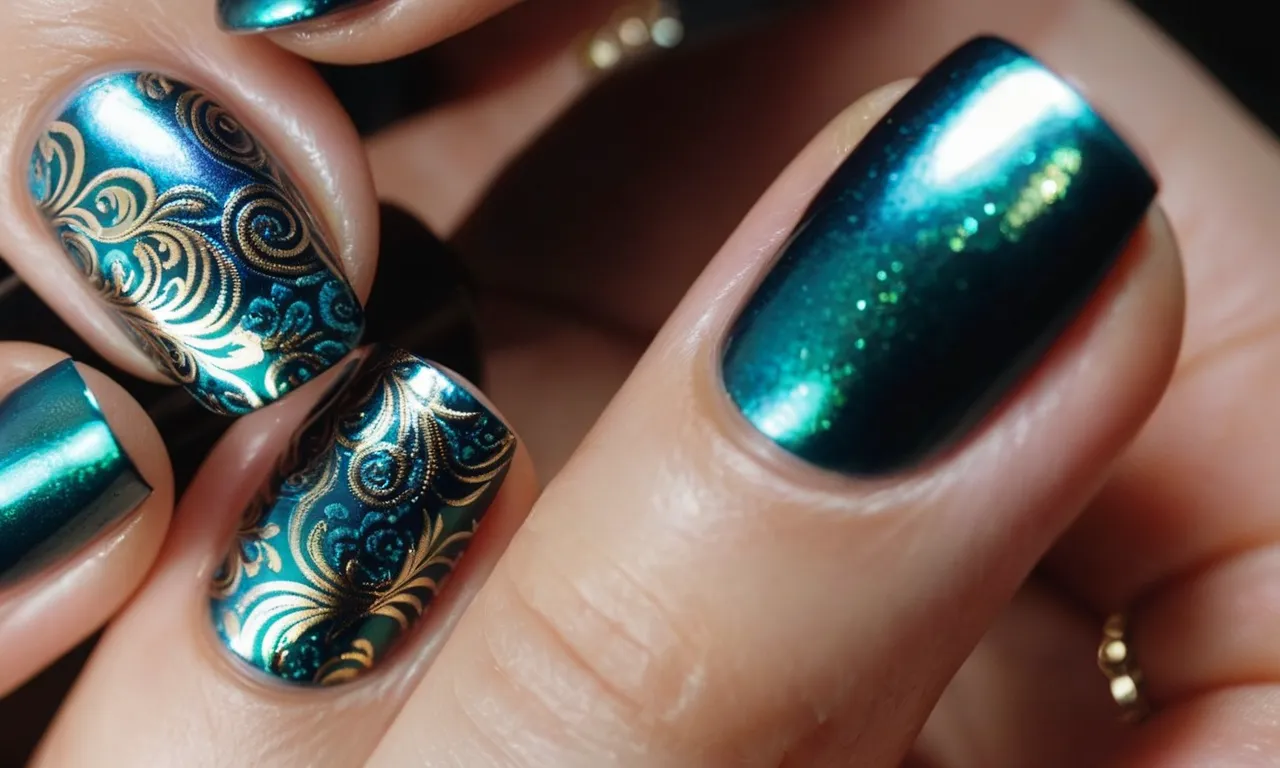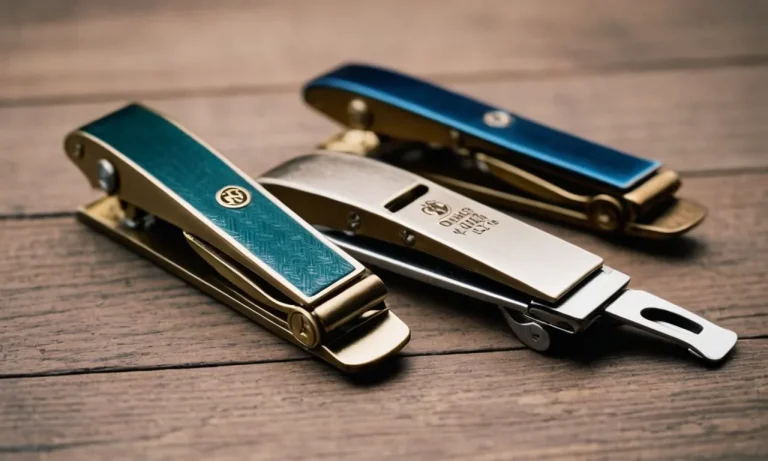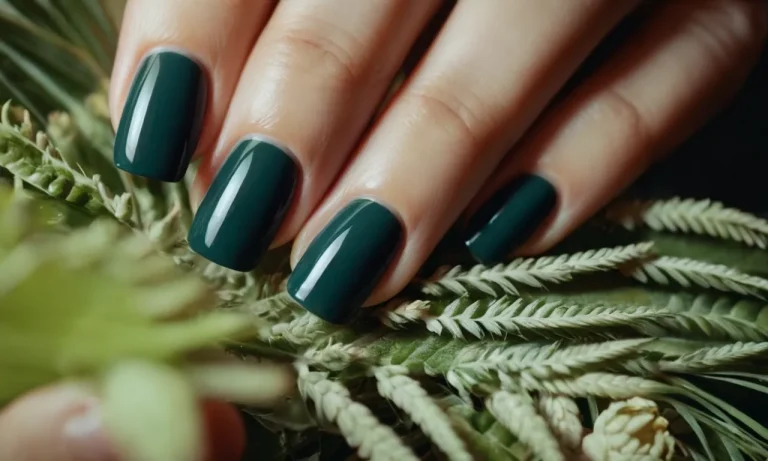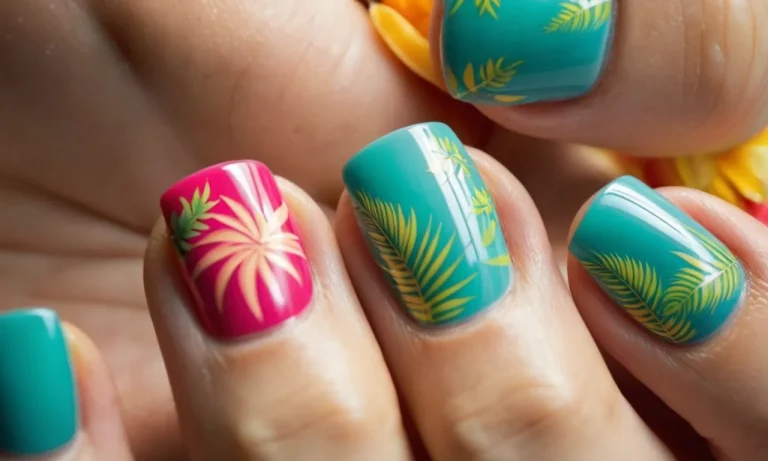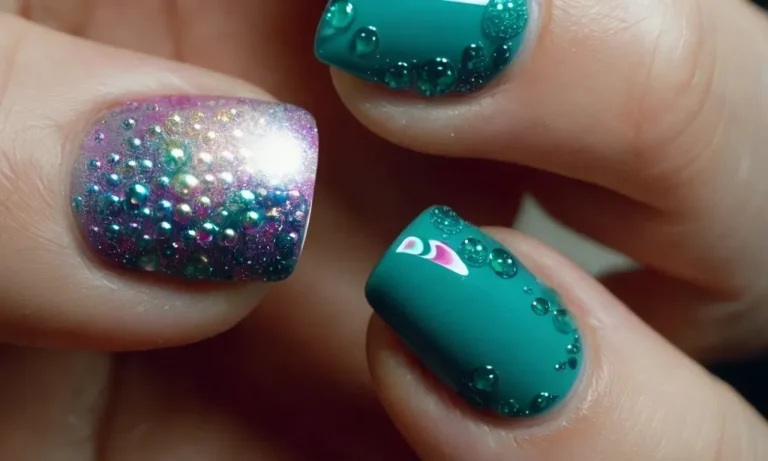How To Use Nail Foil: A Step-By-Step Guide
Adding nail foil can take your manicure from simple to stunning! The glittery, holographic effect is easy to achieve at home with the right supplies and techniques. If you’re short on time, here’s a quick answer to your question: prepare your nails, cut foil to size, apply top coat to the nail, place foil and seal it by applying top coat over the foil.
In this comprehensive guide, we’ll walk through everything you need to know about using nail foil for beautiful, long-lasting nail art and effects. We’ll cover tips for selecting foils, nail prep, sizing and cutting foils, application techniques, sealing the foil, troubleshooting problems, and more.
With the help of this detailed tutorial, you’ll gain the skills to create eye-catching foil nail designs at home.
Choosing Your Nail Foils
Consider color and finish
When choosing nail foils, it’s important to consider the color and finish you want for your manicure. Think about what colors complement your skin tone and which ones match your personal style. Metallic foils like gold, rose gold, and silver are great neutral options that pair well with any outfit.
Holographic and iridescent foils offer a fun, eye-catching effect. If you prefer a subtle look, try solid color foils or French tip foils in a sheer nude or pink. Matte foils give an understated, velvety finish while high-shine foils add drama and glam to your nails.
Buy a nail foil kit
Getting a dedicated nail foil kit can make application so much easier. These kits contain sheets of precut foils, adhesive, and all the tools you need, saving you time and hassle. Look for ones with plenty of foil options so you can switch up your manicure.
A kit with foils for 10-20 full manicures is a good start. Kits from reputable brands like Manime and Born Pretty offer excellent value and come with detailed instructions.
Get extra adhesive
The adhesive that comes in foil kits is essential for proper application. Since you’ll be using it every time, consider picking up an extra bottle or two so you don’t run out halfway through your kit. Adhesive specifically formulated for nail foils will dry quickly and last several days without peeling or popping off.
An oil-resistant adhesive like Gelish Foil Fixer works great and can be purchased individually.
Preparing Your Nails
Trim and shape nails
The first step in preparing your nails for nail foil application is to trim and shape them. Use nail clippers or scissors to trim your nails to your desired length. File the edges of your nails with a nail file to smooth any rough edges and shape them into a rounded or square shape, whichever you prefer.
Having neatly trimmed and shaped nails creates the perfect base for the nail foil to adhere to.
Buff surface
After trimming and shaping, use a nail buffer block to gently buff the surface of each nail. Buffing removes any shine from the nail plate and creates a slightly rough texture for the nail foil to cling to.
You don’t need to buff too much, just a few light passes over each nail to gently exfoliate the surface. Buffing preps the nails and helps the foil last longer without peeling or lifting.
Clean nails
Before applying any products to your nails, it’s important to thoroughly clean them to remove any oil, lotion or debris. Use a nail polish remover containing acetone to wipe each nail plate clean and ensure there is no residue left behind.
You can also give your nails a wash with soap and water before proceeding. Having super clean nails helps the base coat and nail foil properly adhere for the most long-lasting manicure.
Apply base coat
After cleaning, apply a thin layer of base coat evenly over each nail. Let the base coat fully dry before moving to the next step, which usually takes 2-3 minutes. The base coat helps the nail foil bond to your nail. Using a ridge-filling base coat helps smooth out any uneven texture on your nails.
According to nailcarehq.com, a long-lasting base like Orly Bonder Rubberized Basecoat makes foil application easy and helps it last for up to 2 weeks without lifting or peeling. Applying base coat is a critical first step for success with nail foils.
Sizing and Cutting the Foils
Cut foils slightly larger than nail
When preparing your nail foils, it’s important to cut them to the proper size. You’ll want to cut the foil just a little bit larger than the nail to make application easier and allow for any adjusting you may need to do.
If the foil is too large, it can wrinkle or crease when you try applying it. But if you cut it too small, you won’t have enough coverage on the nail and may end up with exposed areas or lifting edges.
A good guideline is to cut rectangular foil pieces that extend just 1-2 mm past the nail edge on all sides. For a more customized fit, you can trace each nail shape on the foil and cut around it.
Use rounded edges
Once you’ve cut your nail foils to the right size, take a nail file or small scissors to round the corners and edges.
Sharply angled foil edges won’t adhere properly to the natural curve of your nails. Gently rounding the corners will help the foil lie flat and prevent lifting or peeling.
It only takes an extra minute or two to soften all the edges, but it makes a big difference! Rounded corners and edges mean perfectly smooth foil application.
Cut multiple foils at once
To save time prepping lots of nail foil pieces, try this handy trick: Stack a few foils together and cut through them all at once.
Simply line up 2-4 foil sheets directly on top of each other. Then, place your nail or template shape over the stack and cut around it with scissors or a craft blade.
You’ll be left with identical foil pieces all ready to apply. It keeps the cutting process quick and efficient.
Here’s a handy comparison of single vs stack cutting:
| Single Foil Cutting | Stack Foil Cutting |
|---|---|
| Cuts one foil at a time | Cuts 2-4 foils at once |
| Takes more time | Faster process |
| Consistency can vary | Identical sizing |
As you can see, stack cutting is the clear winner for efficiency and convenience. Be sure to give this foil cutting technique a try next time!
Follow the guidelines above on properly sizing and shaping your nail foil pieces, and you’ll set yourself up for easy, flawless application. Check out the nail art tutorials on YouTube for video demonstrations on cutting foils. Happy foiling!
Applying the Nail Foil
Paint on adhesive
The key to perfectly applying nail foil is using the right adhesive. Start by painting a thin, even layer of foil glue or adhesive on the nail where you want the foil piece to go. Many foilers swear by products like Gelish Foil Bond or Bluesky Bio Seaweed – which provide the tackiness needed to adhere the foil, without being so sticky that the foil shifts around.
Apply the glue in a precise shape if you want a defined foil design, or all over the nail if doing a full nail foil cover. Let the adhesive get nice and tacky, usually around 10-20 seconds, before moving onto the next step. Rushing this step can lead to failed foil application, so patience is key!
Place foil and smooth gently
Once your nail is prepped with glue, use a tweezer or silicone applicator to gently place your foil piece adhesive-side down onto the nail. Carefully position and smooth out any wrinkles using light pressure – rubbing too firmly can cause the foil to tear or lift.
Work quickly before the adhesive dries and adheres completely.
Many foilers suggest covering the foil with plastic wrap or a flexible silicone tool, then pressing down to maximize contact rather than directly handling the foil with fingers. This helps the foil adhere evenly across the whole nail for a smooth finished look.
Use a silicone applicator
Using a soft silicone applicator tool is the best way to apply foil designs perfectly. The flexible tip allows you to gently smooth and adhere foil across the entire nail surface without tears or lifting. It also lets you create precise foil shapes for detailed nail art.
Silicone applicators can be used to burnish colour changing nail foils too. Simply wipe the colour you want to reveal over the applicator, then rub firmly on the foil to transition it from one shade to another. This gives you so much creative control when working with thermal colour shift foils!
So grab your favourite foil adhesive and silicone applicator and you’ll have stunning, salon-worthy foiled nails in minutes. With a steady hand and these key tips, anyone can master the art of applying nail foils for show-stopping nail designs.🌟
Sealing the Nail Foil
Apply Top Coat Over Foil
Applying a quality top coat is crucial for sealing in the nail foil and ensuring it stays put. Select a fast-drying top coat formulated specifically for nail foil or nail art. These top coats dry with a smooth, glossy finish and help protect the foil design underneath without causing it to wrinkle or lift up over time.
When applying the top coat:
- Use a steady hand to brush on the top coat, making sure to completely cover the foil and extend just past the edges of the design.
- Let the top coat dry thoroughly, at least 5-10 minutes, before touching the nails or doing any other activity with your hands.
- Apply two coats of top coat for maximum protection and shine.
Well-known professional nail care brands like Essie and OPI make specialized top coats ideal for finishing foil nail art and keeping it intact.
Cover Edges to Prevent Lifting
It’s important when applying foil to thoroughly cover the edges with top coat. Exposed foil edges can catch on things and lift up over time. To seal the edges:
- Use the brush to direct ample top coat right up to the perimeter of the foil piece, encapsulating the edge.
- Look at the foil from all angles to check for any visible edges not covered by top coat and touch up if needed.
- Be extra thorough covering edges on parts of the nails that endure more impact and friction, like the tips.
Allow Time to Dry Fully
Nail foil needs sufficient drying time after the top coat before resuming normal activity with the hands. The drying process takes:
| 5-10 minutes | For top coat to initially set |
| 30-60 minutes | To allow for thorough drying and hardening |
| 24 hours | For full curing and maximum durability |
Avoid touching the foil nails, getting them wet, putting on gloves, or doing household chores until the top coat has hardened enough to withstand light friction without damaging the foil underneath, generally 30-60 minutes.
Though technically dry to the touch in minutes, it takes a full 24 hours for most top coats to completely cure and harden to their maximum strength and protective abilities. Taking measures not to chip or peel the foil nails during this initial 24 hour curing period helps ensure the design lasts maximally over 2 weeks or more.
Troubleshooting Problems
Foil won’t stick – not enough adhesive
One of the most common issues when applying nail foil is that the foil doesn’t properly adhere to the nail. This frustrating problem often occurs due to not using enough adhesive on the nail before applying the foil.
To ensure proper adhesion, first prep the nail by lightly buffing and cleaning with alcohol. Next, apply a moderate to thick layer of adhesive gel or glue to the nail. Quickly place the foil while the adhesive is still tacky.
Use a rubber-tipped cuticle pusher to gently smooth out any air bubbles or wrinkles. Once dry, seal the edges with a fast-drying top coat.
Applying too little adhesive is the main reason foil lifts or falls off prematurely. The key is allowing enough sticky surface area for the foil to grab onto. When in doubt, add an extra layer of glue rather than too little.
Foil lifting at edges – seal edges with top coat
Another nuisance with foil nails occurs when the foil begins peeling up around the edges days later. Though properly adhered at first, not taking the extra step to seal the foil down around the perimeter sets the stage for lifting and chips.
The preventive solution is remarkably simple – finish off your foil nails by swiping on a layer of fast dry top coat, taking care to wrap the tips and edges. This sandwiches the foil between the base coat below and seals down the sides, preventing air or moisture from sneaking underneath.
For existing manicures with lifting edges, it’s best to remove the polish and start fresh. When reapplying new foil, remember to completely seal the trimmed edges with a water-tight top coat barrier.
Foil wrinkling – use gentle pressure when applying
Wrinkles and bubbles marring the smooth finish of foil nails also ranks as a leading frustration. Though tempting to use firm pressure hoping to smooth them out, this nearly always makes creases worse.
Foil works best when handled with a delicate touch. Once adhesive is layered onto the nail, lightly place the foil piece on top without shifting it around. Use a soft rubber tool to gently smooth from middle to edges, working out folds and creases carefully.
If deep wrinkles persist, consider gently lifting and repositioning the foil. When lining up the pattern or placement, hover the foil just above the nail before laying down to avoid trapping air pockets underneath.
Rushing the application or applying too much pressure causes more harm than good. Remember – foil wrinkles easily, so handle with care and patience for flawless results.
Conclusion
With some simple preparation and the right technique, it’s easy to applyfoil for elegant, head-turning nail art at home. Always start with properly shaped, clean, and buffed nails. Cut the foil slightly larger than your nail before gently pressing into the adhesive layer.
Finish by encapsulating the foil completely with a good top coat to seal. With a little practice, you’ll be able to get salon-worthy results. So don’t be afraid to add some foil and sparkle to your next manicure!

